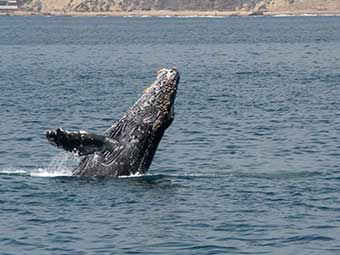Humpback whale: Characteristics, conservation, habitad, reproduction
Discover the Majestic World of Humpback Whales
Reading time : 1 minute,
Discovery Chepe Id-556-ECO
Published in
12-12-2024

Photo: Mike Doherty
Fortunately, commercial hunting of humpback whales has been banned internationally for decades. Thanks to the implementation of moratoriums and conservation efforts, humpback whale populations have managed to recover significantly after being hunted almost to extinction for centuries.
Humpback whales (Megaptera novaeangliae) are known for their long pectoral fins, which can reach up to a third of their total body length. They get their name from the hump they form when they arch their back before diving. Another distinctive feature is the tuberous protuberances on their heads, which are thought to play a role in hydrodynamics and sound production. Regarding their size, on average, an adult can measure between 12 and 16 meters in length. However, females are usually slightly larger than males.
Habitat
These majestic creatures are found in all the world's oceans, although their migration routes vary depending on the population. During the summer, they usually live in cold waters near the poles to feed on krill and small fish. In winter, they migrate to warmer waters to reproduce.

Humpback Whales:Gentle Giants of the Ocean, Conservation and Facts
Photo: Mike Doherty
Feeding
Humpback whales are filter feeders. They use their baleen, a comb-like structure made of keratin, to filter large amounts of water and retain krill. They often employ a feeding technique called "bubble netting," in which they create a net of bubbles around a school of fish to corral them.
Reproduction
Humpback whale reproduction is a complex process. Males compete for females, emitting long, complex songs that can last for hours. After gestation, which lasts about a year, a single calf is born. Mothers care for their calves for several months, providing them with nutrient-rich milk.
Whale Song
One of the most fascinating aspects of humpback whales is their complex communication system. Males produce long, melodious songs that vary between different populations. These songs are thought to serve social functions, such as attracting females and establishing territories.
Migration
Humpback whale migration is truly one of the most incredible natural phenomena. These gentle giants embark on epic journeys, often thousands of miles long, between their feeding and breeding grounds. It's a testament to their resilience and adaptability.
However, climate change poses a significant threat to their migration patterns. Warming waters can disrupt their food sources and alter their traditional routes. It's crucial to protect these magnificent creatures and their habitats to ensure their survival for generations to come.
Conservation
Despite their recovery after being hunted almost to extinction, humpback whales still face threats such as entanglement in fishing nets, marine pollution and climate change. The conservation of these magnificent creatures is crucial to maintaining the balance of marine ecosystems.
Its way of diving: When the whale prepares for a deep dive, it arches or hunches its back very pronouncedly, making the 'hump' even more evident.
8. Increíbles imágenes de una ballena jorobada saliendo a la superficie. Por enorme que sea, sólo tiene la mitad del tamaño de una ballena azul. pic.twitter.com/2s8IdMT70h
— Natalia | Experta en IA (@IA_Natalia_) January 10, 2025
See Also
Discovery Chepe
Most read...















